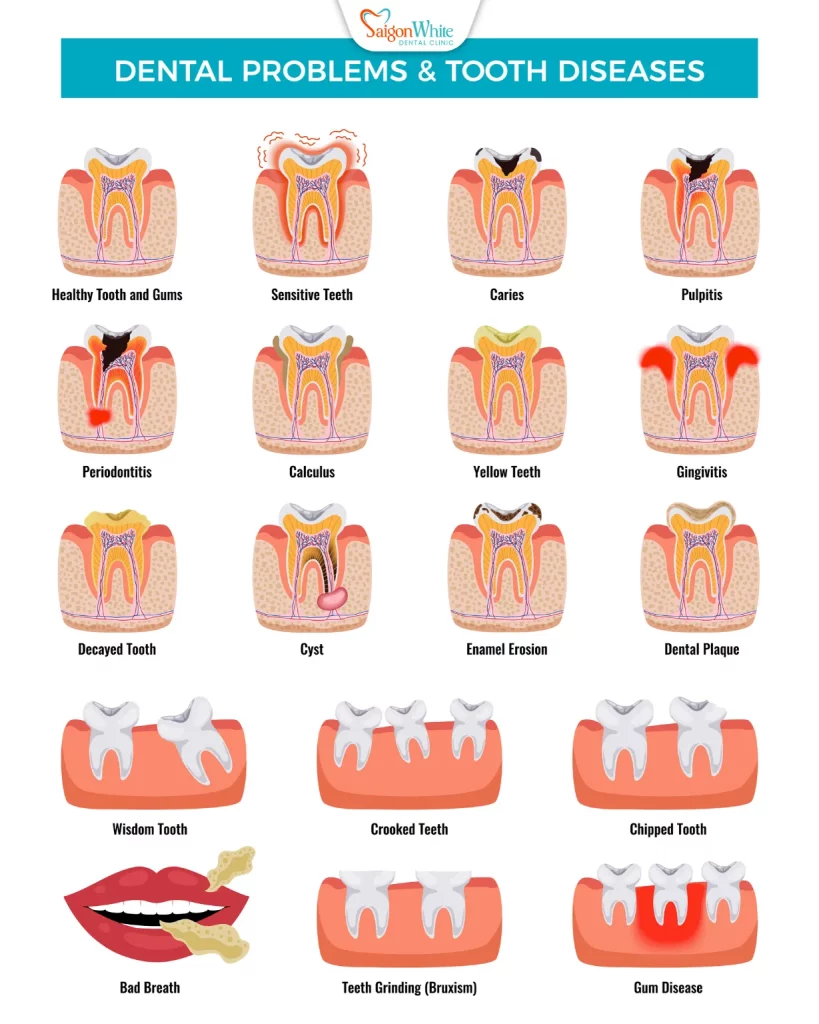Gum disease, also known as periodontal disease, is one of the most common oral health problems worldwide, but also one of the most overlooked. It can develop silently and painlessly until irreversible damage to your gums, bones, and even teeth has already occurred. That’s why understanding the symptoms of gum disease is essential for early detection and treatment.
In this comprehensive guide, we’ll help you recognize the warning signs of gum disease, from mild to severe stages, so you can take action before it’s too late.

What Is Gum Disease?
Gum disease refers to inflammation and infection of the tissues surrounding your teeth. It typically starts as gingivitis—the early, reversible stage—and can progress into periodontitis, a more serious condition that affects the bone supporting your teeth.
Two Main Stages of Gum Disease:
- Gingivitis: Mild inflammation of the gums caused by plaque buildup. Usually reversible with proper care.
- Periodontitis: Advanced gum infection that damages the soft tissue and bone, potentially leading to tooth loss.
Early Signs of Gum Disease (Gingivitis Symptoms)
Gingivitis is the earliest form of gum disease, and the good news is that it can be reversed if treated early. Here are the most common symptoms to watch for:

Red, Swollen Gums
Healthy gums are usually firm, pale pink, and tight against your teeth. When gingivitis sets in, your gums may become:
- Puffy or swollen in appearance
- Bright red or darker than usual
- Tender or slightly painful to the touch
This inflammation is your body’s response to the bacteria irritating your gums.
💡 Swollen gums are often the first visual sign of gingivitis, even before you feel any discomfort.
Bleeding Gums During Brushing or Flossing
One of the hallmark signs of early gum disease is bleeding when brushing or flossing. Many people assume it’s normal—but it’s not. Gums that bleed easily indicate:
- Inflammation and breakdown of gum tissues
- Fragile blood vessels due to bacterial attack
- The presence of plaque and tartar under the gum line
Even light flossing shouldn’t cause bleeding. If it does, it’s time to get a professional cleaning.
Gum Tenderness or Discomfort
In the early stages of gingivitis, your gums may not be severely painful, but they may:
- Feel sensitive when brushing or eating
- React to hot or cold foods
- Aches slightly when pressed
This tenderness is caused by irritation and early inflammation, which may go away temporarily but will return if not treated.
Persistent Bad Breath (Halitosis)
If you brush your teeth and use mouthwash, but your breath still smells bad, gingivitis may be the underlying cause. The bacteria responsible for gum inflammation produce volatile sulfur compounds (VSCs), which:
- Smell unpleasant
- Linger even after cleaning
- Worsening as the infection spreads
Chronic bad breath is often the first invisible symptom of gum disease.
Gum Color Changes
A subtle but important sign is a change in the color of your gums. Healthy gums are pale pink, while inflamed gums may appear:
- Reddish-pink
- Dark red or purple
- Slightly shiny or overly smooth in texture
These changes often go unnoticed unless you’re actively looking for them, but they indicate that your gums are struggling to fight off bacterial invasion.
Gum Sensitivity to Touch
If you avoid brushing or flossing certain areas because they feel “weird” or overly sensitive, you might be in the early stages of gingivitis. This can occur especially:
- Around molars or crowded teeth
- In areas where food gets stuck easily
- Where tartar has begun to accumulate
Sensitivity can be a precursor to more serious gum issues and should not be ignored.
Receding Gum Line (Early Gum Pullback)
In some cases, gingivitis can cause the gum line to start pulling away from the teeth slightly. This might look like:
- Your teeth appear “longer”
- Tiny pockets or gaps forming at the base of your teeth
- A slight indentation between the gum and tooth
Gum recession at this stage is usually mild and reversible with proper care—but it’s a warning sign of potential progression to periodontitis.
Soft or Spongy Gums
Instead of being firm and springy, gums affected by gingivitis may feel:
- Soft when touched with your finger
- Mushy or gelatinous when brushing
- Less resilient than healthy gum tissue
This is due to fluid buildup from inflammation and a weakening of the tissue structure.
Advanced Symptoms of Gum Disease (Periodontitis)
When gingivitis is left untreated, it can progress into periodontitis, which causes irreversible damage to the gums and supporting bone.
Here are the advanced symptoms you shouldn’t ignore:
1. Gum Recession
One of the most obvious signs—your teeth start to look longer because the gum tissue is pulling away.
2. Loose or Shifting Teeth
As bone and gum tissue deteriorate, your teeth may feel loose, shift in position, or develop new spaces between them.
3. Persistent Bad Breath or Bad Taste
Even after brushing, the odor returns. This is caused by decaying tissue or pus.
4. Pain When Chewing
Inflamed and infected gums can make chewing feel uncomfortable or painful.
5. Plaque Between Teeth and Gums
Visible signs of infection may appear as pus oozing from gum pockets.
6. Change in Bite
If your teeth don’t align the way they used to, it could be due to shifting caused by bone loss.
⚠️ Periodontitis requires professional treatment to stop progression—home care alone will not be enough.
Visual Signs of Gum Disease
Sometimes, gum disease is visible even before you feel symptoms. Here’s what to look for:
- Purple or Dark Red Gums: A sign of advanced inflammation or infection.
- Tartar Buildup: Hardened plaque at the gum line encourages bacterial growth.
- Gum Pockets: You may feel your floss “dip” lower into the gums—a sign they are detaching.
- Tooth Root Exposure: The base of your teeth may become visible, especially near the molars.
If you see these signs, don’t wait—get your gums checked professionally.
Silent Symptoms: No Pain Doesn’t Mean No Problem
One of the most dangerous aspects of gum disease is that it often develops without pain. Many patients assume that “no pain = no problem”—but that’s a myth.
You could be suffering from significant gum and bone loss without realizing it until your teeth become loose or fall out.
That’s why regular dental check-ups are vital—even when everything “feels fine.”
Gum disease is sometimes called the “silent destroyer” of teeth.
When Should You See a Dentist?
You should book an appointment with a dentist or periodontist if you notice:
- Bleeding when brushing or flossing
- Receding gum line
- Persistent bad breath
- Pain while chewing
- Gums pulling away from teeth
- Loose or shifting teeth
Even if you’re unsure, it’s better to have a quick evaluation than wait until the condition worsens.
Most dentists recommend a 6-month check-up, but if you’re at higher risk, more frequent visits may be necessary.
Risk Factors That Make Gum Disease Worse
Several lifestyle and health conditions increase your risk of developing or worsening gum disease symptoms:
| Risk Factor | Impact on Gums |
| Smoking | Reduces blood flow to gums, masking symptoms |
| Diabetes | Increases susceptibility to infection |
| Poor Oral Hygiene | Bacteria accumulate and damage gum tissue |
| Stress | Weakens the immune response |
| Genetics | Some people are genetically predisposed |
| Hormonal changes | Especially during pregnancy or menopause |
| Medications | Some drugs cause dry mouth, leading to gum issues |
If you fall into any of these categories, be extra vigilant and get regular periodontal check-ups.
How to Prevent Gum Disease Symptoms
The good news is that gum disease is largely preventable. Here’s how to protect your gums before symptoms start:
1. Brush Twice Daily
Use a soft-bristle toothbrush and fluoride toothpaste. Don’t forget the gum line!
2. Floss Daily
Flossing removes plaque and food particles between teeth that brushing misses.
3. Use an Antibacterial Mouthwash
It helps reduce bacteria and freshens breath.
4. Get Professional Cleanings
Visit your dentist every 6 months (or more often if needed) for scaling and gum evaluation.
5. Quit Smoking
Tobacco is a major contributor to gum disease and reduces healing ability.
✅ An ounce of prevention is worth a pound of cure—especially with gum disease.
FAQs About Gum Disease Symptoms
Can gum disease be reversed?
Yes, gingivitis can be reversed with improved oral care and professional cleaning. However, periodontitis is only manageable, not reversible.
Do gums grow back after they recede?
No. Gum tissue doesn’t grow back naturally. Severe recession may require grafting surgery.
Are bleeding gums always a sign of gum disease?
Often yes, especially if bleeding is consistent. However, aggressive brushing can also cause bleeding—your dentist can confirm the cause.
How fast does gum disease progress?
It varies. Some people develop advanced symptoms in months; others over years. Genetics, hygiene, and habits play a role.
Can you have gum disease without cavities?
Yes! Gum disease affects soft tissue and bone, while cavities affect tooth enamel. You can have perfect teeth and still have serious gum issues.
Recognize the Signs, Protect Your Smile
Gum disease doesn’t happen overnight, but ignoring early signs can lead to long-term damage and tooth loss. Knowing the symptoms—like bleeding gums, bad breath, gum recession, or loose teeth—can help you act early.
If you experience any of the symptoms discussed in this article, don’t wait. Schedule a professional dental check-up and get your gums evaluated.
Book a Gum Check-Up Today
Your smile’s foundation is your gums. Keep them healthy, and your teeth will thank you for a lifetime.
If you’re in Ho Chi Minh City, we recommend trusted clinics like Saigon White Dental, where English-speaking professionals offer thorough gum assessments, deep cleaning, and advanced periodontal care.

 Telegram
Telegram